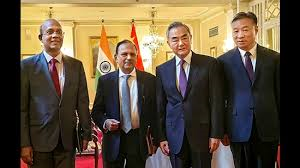India and China have agreed to accelerate efforts to achieve complete disengagement along the contested Himalayan border, New Delhi announced on Thursday. This agreement came after a key meeting between India’s National Security Adviser (NSA) Ajit Doval and China’s Foreign Minister Wang Yi in Russia.
The discussions, held on the sidelines of an international forum, focused on reducing tensions along the Line of Actual Control (LAC), the de facto border between the two countries, where both nations have been locked in a standoff since mid-2020. Despite several rounds of talks, the situation has remained tense, with both sides maintaining a significant military presence in the region.
During the meeting, NSA Doval and Foreign Minister Wang Yi emphasized the need for complete disengagement in order to restore peace and stability along the border. “Both sides agreed to redouble their efforts and work towards a full and peaceful resolution,” a statement from New Delhi said, reiterating India’s commitment to diplomacy as the way forward.
Key Points from the Meeting
The talks in Russia provided a significant diplomatic opportunity for both India and China to address the ongoing border tensions, which have periodically flared up since the deadly Galwan Valley clashes in June 2020. Since then, multiple high-level talks have taken place, including military and diplomatic negotiations, but progress has been slow.
In Thursday’s meeting, both Doval and Wang Yi reaffirmed their countries’ commitment to reducing border tensions through dialogue. India’s primary focus remains on restoring the status quo ante as of April 2020, before the border clashes began. Doval emphasized that a peaceful resolution requires the full disengagement of troops from all friction points along the border.
China’s Foreign Minister Wang Yi, for his part, highlighted the importance of mutual trust and cooperation in managing bilateral differences. He called for continued communication at both the diplomatic and military levels to ensure a lasting resolution to the dispute. Wang reiterated China’s stance that both nations should work together to avoid any escalation that could harm their broader relationship.
Border Tensions and the Path Forward
The Himalayan frontier between India and China has been a source of friction for decades, with both nations claiming territories in the region. The current standoff, which began in May 2020, has seen several rounds of talks and partial disengagements, but tensions have remained high.
The meeting between Doval and Wang Yi is seen as a positive step in breaking the current impasse, though experts caution that the process of disengagement is likely to be slow and complex. Both sides have substantial strategic interests in the region, making it difficult to reach a quick resolution. The ongoing military build-up on both sides of the LAC continues to pose a challenge to achieving full disengagement.
Nevertheless, the fact that both countries are willing to continue talks is seen as a positive signal. The commitment to resolving the issue through dialogue and diplomatic means aligns with both India and China’s desire to avoid any further escalation of hostilities.
Broader Implications for India-China Relations
The talks come at a time when India and China’s broader relationship is under strain due to the border dispute. However, both countries have important economic and geopolitical interests that make resolving the issue critical for regional stability. China is one of India’s largest trading partners, and any prolonged conflict at the border could have wider ramifications for both nations’ economies.
Moreover, the meeting between Doval and Wang Yi took place against the backdrop of broader international concerns over regional stability in South Asia. The ongoing tensions between India and China have drawn the attention of global powers, with several countries urging both sides to resolve their differences peacefully.
Conclusion
The recent meeting between India’s NSA Ajit Doval and China’s Foreign Minister Wang Yi marks another attempt by both nations to defuse tensions along their contested Himalayan border. While much work remains to be done, the commitment to accelerating disengagement and pursuing dialogue provides hope that both countries can eventually restore peace and stability along the Line of Actual Control.
As India and China continue to engage diplomatically, the international community will be watching closely, hopeful that the two neighboring powers can find a way to resolve their differences without further conflict.




